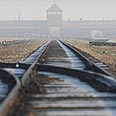
Train retraces route of 1st Auschwitz convoy
Exactly 70 years after Nazi German troops packed them into train cars, handful of Auschwitz survivors gather Monday to commemorate first ever rail convoy to notorious camp
A special memorial train set off Monday morning from the southern Polish town of Tarnow, retracing the original 140-kilometre (87-mile) route to Oswiecim, site of the Auschwitz-Birkenau death camp.
A trio of aging survivors are scheduled to travel on the memorial trip organized by the Association of Auschwitz Families, while a further six are expected at a ceremony at the camp itself.
A total of 1.1 million people perished at Auschwitz-Birkenau during World War II, according to figures from the camp's memorial museum.
A million were Jews from Poland and across Nazi-occupied Europe. The camp is an enduring symbol of the Holocaust.
The other victims included some 75,000 non-Jewish Poles, 21,000 Roma, 15,000 Soviet prisoners of war and up to 15,000 others including resistance members from other occupied nations.
The Nazis set up Auschwitz in a former Polish army barracks in 1940, almost a year after sparking World War II by invading Poland.
Later expanded into a purpose-built death camp for Jews, the site's initial role was to hold and kill Poland's elites and stem underground resistance to the brutal Nazi occupation. Timeline: The history of Auschwitz
'Like ground fell away beneath our feet'
On June 14, 1940, 728 men from a jail in Tarnow were loaded into a stifling train.
Among them was Kazimierz Albin.
He was just 17 when Germany invaded Poland in September 1939. Unbowed, he chose to follow thousands escaping to join a Polish exile army in France.
He was arrested in January 1940 trying to cross into Slovakia.
On the train, Albin and his comrades learned from their captors that the Germans had just conquered Paris.
"It was like the ground fell away beneath our feet. Our goal had been France and joining the Polish army there, and now Paris was occupied and France had surrendered," he told AFP in a recent interview.
On arrival, the Poles had numbers tattooed on their arms. Albin still bears his, 118.
The captors' message was stark, Albin recalled: "You are in a German concentration camp because you are enemies of the German people. All disobedience or attempts to escape will be punished with the death penalty".
After suffering beatings and torture, the inmates were put to work as forced labourers extending the camp for new arrivals.
Nearby Birkenau opened in the spring of 1942, and fast became a hub for the "Final Solution" as the Nazis murdered Jews en masse in its gas chambers and burned the bodies.
Before managing to escape in February 1943, Albin gleaned information from inmate-overseers – the notorious "Kapos" – about Birkenau. He still remembers the smell of the burning corpses.
Auschwitz-Birkenau was liberated by Soviet troops in January 1945.
Some 300 men from the first convoy survived the war.










